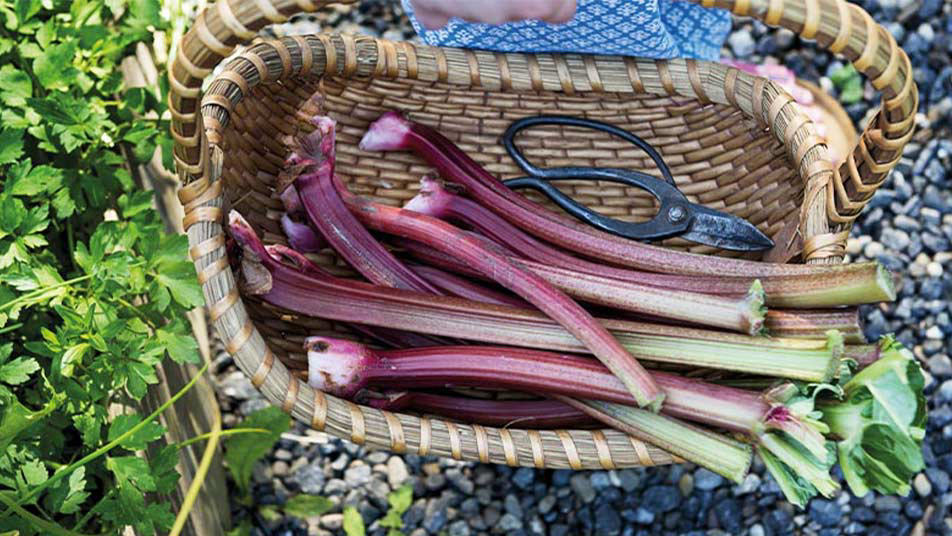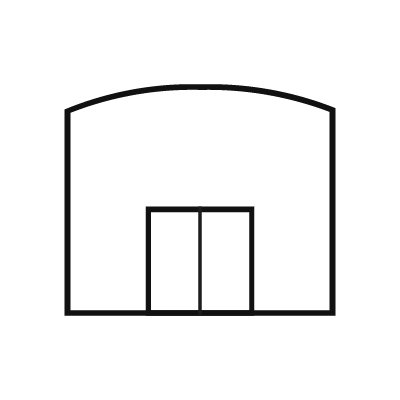
WHAT DO I NEED TO GROW RHUBARB?
Your choice of rhubarb varieties
Garden spade and trowel
Well-rotted farmyard manure or garden compost
An outdoor pot at least 50cm deep and wide (if planting in container)
Top tip:
Young rhubarb plants are known as “crowns”. These are plants that have previously been divided from healthy, strong established rhubarb plants and are usually around one year old

Know Your Rhubarb
The flavour of rhubarb and when you can harvest it depends on the age of the plant and its variety. If you’re not sure where to start, here are some of our favourite kinds to grow:
Rhubarb ‘Timperley Early'
This reliable early season rhubarb variety is known for its succulent stems, delicious flavour and excellent cropping performance - particularly when forced (covering a plant to make it grow outside of its normal season)
Rhubarb ‘Victoria’
A main season variety that’ll give you a generous crop of red string-free stems that are juicy and sweet with a tart punch - ideal for pies and preserves. This variety is particularly hardy and easy to grow
Rhubarb ‘Champagne’
A popular variety known for its beautifully sweet and tender brightly coloured stems. Regarded as one of the earliest and best varieties for forcing, it’s both reliable and simple to look after
WHEN TO PLANT RHUBARB
Rhubarb plants will happily grow if planted out at any time of year, as long as the weather isn’t extremely hot or dry. Spring or autumn are the preferred seasons for most gardeners
WHERE TO PLANT RHUBARB
Where rhubarb grows best is in a sunny or partially shaded location with moist but well-draining soil. For stronger growth, mix manure into your soil before planting. You should avoid planting in waterlogged soil and areas in your garden that are prone to bouts of frost

Planting rhubarb
You’ve chosen a variety and the perfect planting location - now it’s time to decide how you’d like to grow your rhubarb:
How to plant rhubarb in the ground
Prepare your planting site by digging in a good amount of well-rotted manure
Rhubarb requires plenty of space to grow as it forms large, wide clumps of stalks. Leave about 30 inches/80cm between each plant
Dig a hole that’s slightly bigger than the roots of the plant
Position the plant in the ground so that the tip of the crown (where leaves appear) sits about an inch below the soil surface
Fill the hole back in, firm the soil, then water well
How to plant rhubarb in a container
Don’t worry if you don’t have enough space to plant rhubarb in the ground. Planting in a container allows you still enjoy their sweet stalks. You can also choose to plant rhubarb in a container if the soil in your garden is heavy or becomes easily waterlogged
To plant rhubarb in a container:
Choose a large container at least 50cm deep and wide, with plenty of drainage holes
Fill the container with a peat-free soil-based compost and use the same planting method as you would when planting in the ground
Rhubarb in containers should be watered regularly as the compost dries out more often than it would in the ground. Keep the soil moist to touch. During any spells of heavy rain, make sure your container can drain freely by sitting it on pot feet, or keep it under shelter

HOW LONG DOES RHUBARB TAKE TO GROW?
Growing rhubarb requires a bit of patience, but it’s worth the wait! Rhubarb can take a year to establish, and two or three years to start growing plenty of harvestable stems
HOW TO CARE FOR RHUBARB
Once planted in the ground, rhubarb needs little maintenance - it's one of the easiest veggies to care for. However, here are some things you can do to ensure you’re getting the best out of your rhubarb plants:
Rhubarb are hungry plants, so feed them annually with farmyard manure or garden compost
Mulch your plant every spring to help retain moisture – make sure not to bury the crown when doing so
Keep your rhubarb plants well-watered in their first year. Once established, you can cut back on watering them, only doing so if the soil dries out, or if the weather is especially dry and warm
If you need an extra growth boost, add chicken manure
Remove any flower stems at the base and cut away faded leaves. Keep in mind some rhubarb varieties are more prone to flowering than others
Rhubarb naturally dies down in winter and becomes dormant – when this happens, cover the area around the plant with new compost to suppress the growth of weeds
To keep plants producing strong crops for a longer time, divide the crowns every few years when the plant is dormant between autumn and spring. When replanting crowns, make sure each one has an “eye”, where shoots will grow

HOW TO FORCE RHUBARB TO GROW
Forcing a plant simply means making it actively grow outside of its normal growing season. Using this method with rhubarb gives you early, tender-sweet stems that can be harvested then cooked or frozen for later use. Here’s the steps you need to follow if you want to force your rhubarb plant:
Cover the crown before the start of the growing season (normally during winter months) with an ornamental forcer or a large, upturned pot which excludes light
If you’re growing in a container, cover up the crowns after potting up and place the container in a cool greenhouse
Rhubarb stalks grow quickly once they start to appear, so check in on them regularly - they’ll be ready to harvest in around 4 weeks
Once you’ve harvested these forced stalks, uncover the plant and allow it to grow normally for the rest of its growing season
COMMON PROBLEMS WHEN GROWING RHUBARB
Rhubarb is a hardy plant. While you shouldn't run into too many problems when growing it, you should still look out for some issues that can crop up at any time:
Slugs and snails – These pests can damage the young shoots of your new plants. Use organic pest repellents to deter them. Make sure you choose a product that’s certified for organic use
Late, unexpected frosts – Unpredictable weather can also damage the young shoots of rhubarb plants. Use frost protection fleeces if you’ve already planted and freezing temperatures are forecast
Rotting – This is probably the biggest threat to rhubarb plants. To prevent rotting, make sure your plant isn’t left in damp or wet conditions, especially in winter. Plant it in a proper site and make sure it has adequate drainage. If you notice parts of your plant rotting, cut them away immediately before it spreads and ruins your hard work
Top tip:
Avoid forcing the same plant in consecutive years

How to harvest rhubarb
Avoid harvesting newly planted rhubarb in its first year. From the second year, pick a few stems gradually as they grow. From year three and onwards, the stems should be ready to harvest as normal. Only harvest a few stems at a time so your plant can remain in active growth
The best months to harvest rhubarb in is during spring and early summer, from March to June
To harvest rhubarb, wait until the stems have grown to about 30cm. Firmly hold the base of the stem and twist gently to ease it out of the ground. Avoid snapping the stems as the leftover stump can rot and damage the crown
Always remove the leaves of rhubarb before cooking or eating as rhubarb leaves are poisonous if consumed. You can simply twist the leaves off and add them to your compost pile as you pick
Once you’ve harvested your rhubarb, you can start enjoying it in all your favourite recipes. Stew it, bake it, or serve it in a pie or crumble with custard for an extra delicious dessert. You can freeze rhubarb for later use, but it’s always tastiest when eaten fresh
Top tip:
Stop picking stalks from July to let plants build reserves for the next spring



